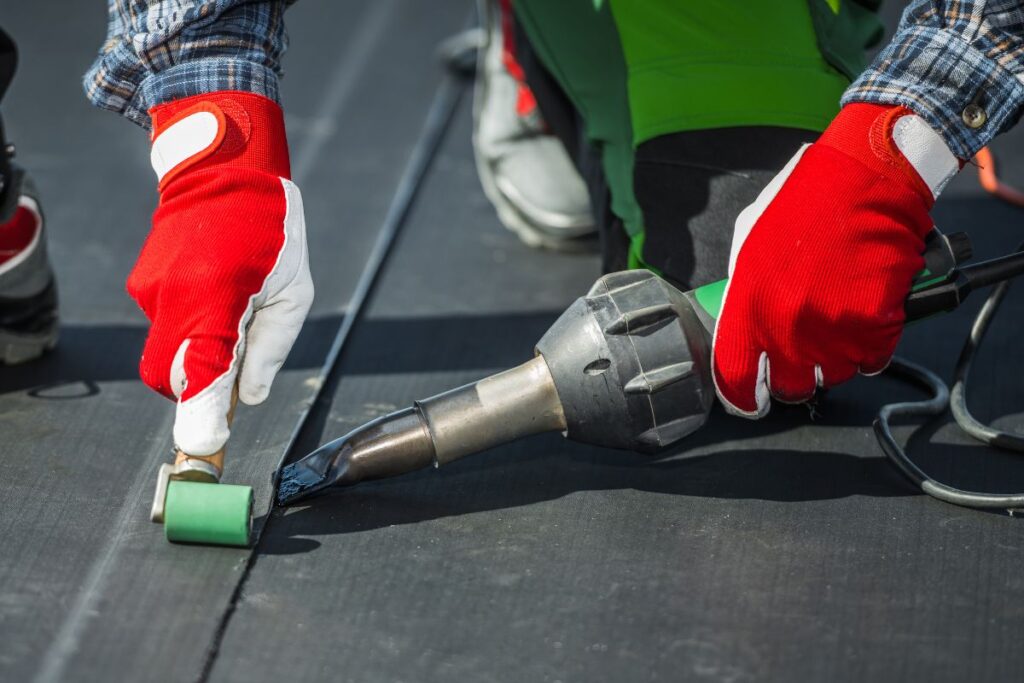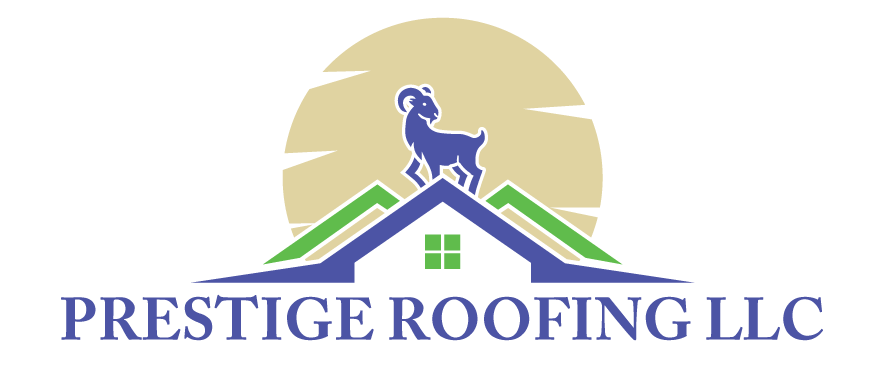If you own a home with a flat or low-slope roof, you’ve probably heard the term “built-up roof” before. This popular flat roofing material has been a staple in roofing for over a century and was introduced as early as the 1850s.
When a material has been around for so long, the trust of property owners is bound to be there. However, the same history may raise concerns. With newer roofing technologies and materials on the market, is a built-up roof still a smart choice for homeowners looking to replace their flat roofs?
The short answer is it depends. While built-up roofs still offer some distinct benefits, they also come with limitations that make newer roofing systems more attractive in certain situations.
At Prestige Roofing LLC, our goal is to provide a clear picture to property owners so they can make better decisions when it comes to home improvement projects. In this blog post, we will look at the pros, cons, and alternatives to built-up roofs to help you make an informed decision.
What Is a Built-Up Roof (BUR)?

A built-up roof is exactly like the word suggests, it is a roofing system built up of several layers. This traditional flat roofing system consists of multiple layers, also known as plies, of asphalt-induced felt or fabric, alternated with bitumen (asphalt or coal tar) and topped with a protective layer of gravel or a reflective coating. These layers create a thick, durable membrane that protects against water infiltration.
BUR has been a go-to roofing system for over 100 years for flat and low-slope roofs, thanks to its reliable performance and long lifespan.
Note: A built-up roof is also known as a tar and gravel roof or a gravel roof. If your contractor uses these names, keep in mind they are the same thing.
Why Flat Roof Owners Still Choose Built-Up Roofs
Built-up roofs remain a viable option for commercial properties and flat-roof homes thanks to their proven reliability. Below are the key benefits that prove that this roof can still hold up under the right conditions.
Exceptional Protection Against Water Damage
If you are living in an area that receives more than average rainfall, you need to find a roofing material that stays waterproof over its lifespan. A built-up roof passes this test.
One of the standout advantages of a BUR is its superior waterproofing capabilities. The multi-layered construction, made of alternating bitumen and felt, creates a thick, virtually impenetrable membrane. This design makes BUR highly effective at preventing leaks, even on flat roofs that are prone to water pooling and slow drainage. For homeowners in areas with heavy rain or snow, this added protection reduces the risk of water infiltration, which can lead to costly interior damage or mold issues.
Long-lasting and Resilient with Proper Maintenance
A built-up roof can last anywhere from 20 to 30 years or longer with professional installation and regular maintenance. The protective gravel or reflective coating shields the underlying layers from harmful UV rays, temperature fluctuations, and physical wear from foot traffic. This durability makes BUR an attractive option for homeowners who plan to stay in their homes for decades and want a roofing system that won’t require frequent replacements.
Enhanced Fire Resistance for Greater Safety
BUR systems offer excellent fire resistance, making them a safer roofing choice, especially in regions prone to wildfires. The top layer of gravel or specialized surfacing material acts as a fire retardant, reducing the risk of flames spreading across the roof. For homeowners concerned about fire safety, this added protection can provide peace of mind and potentially lower insurance premiums.
Cost-Effective for Larger Flat Roofs
For homes with expansive flat roofs, BUR can be more cost-effective than some modern single-ply roofing systems. Its broad, uniform coverage makes it efficient for large surface areas, potentially reducing material and labor costs. This makes BUR particularly appealing to homeowners with bigger properties who want a durable solution without significantly increasing their roofing expenses.
Why a Built-Up Roof Might Not Be the Best Choice for Your Home
While built-up roofs offer durability and solid weather protection, they also come with several drawbacks. These drawbacks have led to the development of some great modern roofing alternatives, which we will discuss later in this article. Here’s why a gravel flat roof may not be the most practical option for your flat roof:
Installation Can Be Time-Consuming and Disruptive
Installing a BUR is a labor-intensive and messy process. It involves melting bitumen, applying hot tar, and layering felt sheets, and each step requires precision and time. The process can generate strong odors and fumes that may linger for days. Depending on the size of your roof, installation could take several days or even weeks, making it highly disruptive. For homeowners, this means dealing with noise, mess, and limited access to outdoor areas during the project.
Excessive Weight Can Strain Your Home’s Structure
A built-up roof is made up of many layers, sometimes up to five, making it heavier than modern single-ply roofing options. The multiple layers of bitumen and gravel add substantial weight. Though most buildings are ready for it, there are chances the weight can strain your property’s structure. If your property isn’t designed to support that load, you may need to reinforce the roof deck and rafters, adding to your overall costs.
Ongoing Maintenance Can Be Expensive
While BURs are known for their longevity, they require regular maintenance to stay effective. Over time, the protective gravel layer may erode, exposing the underlying bitumen to UV rays and weather damage. Cracks, blisters, or surface deterioration can develop, requiring professional repairs. These maintenance expenses can add up in the long run and might require frequent intervention from your side.
Limited Energy Efficiency Can Increase Cooling Costs
Traditional BURs tend to absorb and retain heat, which can make your home warmer and increase your cooling costs during the summer. Although some BUR systems now include reflective coatings, they still fall short of the energy efficiency offered by newer roofing technologies.
Modern Roofing Alternatives to Consider For Replacing Your Flat Roof
If you’re replacing your flat roof, it’s worth comparing BUR with newer roofing options. In many cases, these modern systems offer greater efficiency, easier installation, and lower long-term maintenance costs.
TPO (Thermoplastic Polyolefin)

TPO is a single-ply membrane roofing system that offers excellent durability and energy efficiency. Out of all popular roofing materials, it is one of the most recently introduced in the industry. TPO is available in roofing rolls that have a bright white color. Due to this, TPO is one of the most sought-after roofing materials when it comes to reflectivity. It also provides good puncture resistance.
Advantages over BUR:
- Faster and cleaner installation.
- Highly reflective, may lower energy costs.
- Lightweight, reducing strain on your home’s structure.
Ideal for: Homeowners seeking a low-maintenance, energy-efficient solution.
EPDM (Ethylene Propylene Diene Monomer)

EPDM is a rubber roof membrane that’s durable and flexible. Unlike a gravel roof, EPDM is a single-ply roll that is tear-resistant. You can expect an EPDM roof to last for more than 30 years with minimal repairs during its lifespan.
Advantages over BUR:
- Fewer seams, reducing the risk of leaks.
- Easier and faster to install.
- Lower material and labor costs.
Ideal for: Commercial property owners and homeowners seeking an affordable, reliable flat roofing option.
Get Started On Your Flat Roof Replacement With Wisconsin’s Leading Roofing Company
If you’re replacing your flat roof, it’s worth exploring all your options. While a built-up roof still offers solid protection, it may not be the most practical or cost-effective choice. Newer systems can provide equal or better performance with less hassle and lower long-term costs.
At Prestige Roofing LLC, we offer the best flat roofing services in Northeastern Wisconsin. We install both TPO and EPDM membrane roofing systems on both large commercial facilities and smaller homes. Contact us today at (920) 791-0414.

